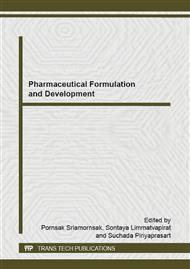p.168
p.172
p.176
p.180
p.184
p.188
p.192
p.199
p.203
Role of Temperature Change on Poly(DL-lactic acid) Porous Matrix Film Fabrication by Solvent Casting Method
Abstract:
Poly(lactic acid) (PLA) has a variety of applications. It has been widely used in the biomedical and pharmaceutical fields due to its biocompatibility and biodegradability. Polyethylene glycol (PEG) is used as an inactive ingredient in the pharmaceutical industry as a solvent, plasticizer, surfactant, ointment base, suppository base, tablet lubricant and capsule lubricant. The aim of this study was to determine the effect of temperature change on PLA porous matrix film fabricating by solvent casting method with an addition of PEG400 to improve and increase the pore interconnectivity. Their mechanical properties such as tensile strength (TS) and % elongation at break (%E) and morphology were investigated. Porous films were prepared at 4 °C for 24 h and dry at room temperature for 24 h (4CRT), 4 °C for 24 h and dry at 60 °C for 24 h (4C60C), -20 °C for 24 h and dry at room temperature for 24 h (-20CRT), -20 °C for 24 h and dry at 60 °C for 24 h (-20C60C), -80 °C for 24 h and dry at room temperature for 24 h (-80CRT), and -80 °C for 24 h and dry at 60 °C for 24 h (-80C60C). 4C60C exhibited the highest strength and toughest, however all of samples showed the quite soft behavior. From topography study they displayed the different porous structure which sample of 4C60C displayed the smallest porous structure. Therefore, the temperature change between the fabrication processes affected the TS, %E and morphology structure of PLA porous matrix films.
Info:
Periodical:
Pages:
184-187
Citation:
Online since:
December 2014
Authors:
Keywords:
Price:
Сopyright:
© 2015 Trans Tech Publications Ltd. All Rights Reserved
Share:
Citation:


